EVENT
Weekends filled with Walleye in Canada!!! –André Gervais
Yo-Zuri hardbaits are the staple in every one of my tackle boxes. But, I especially rely on them when chasing after the big walleyes that we are notorious for in Canada. I really enjoy walleye fishing on the weekend because there are no two trips the same, and the walleye are very aggressive fish. It is always a great opportunity to hit the water and spend time with great fishing buddies and family.
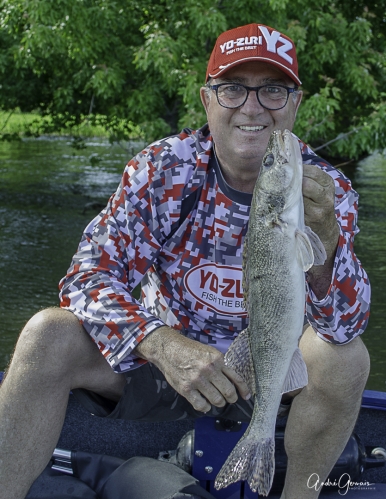
For most of my life I have known the best way to catch walleye is by trolling. This is a pretty simple technique done by boat: tie on a Yo-Zuri Crystal Minnow Walleye DD, throw the bait behind the boat and drive at a steady slow pace. A critical element to being successful and a common question I hear a lot is, “what speed should I troll at?” this is dependent on the bait you are throwing and the depths you want to target. For me I prefer a really slow speed to help the Yo-Zuri Crystal Minnow Walleye DD dive to a depth of 8-9 feet. This seems to be a perfect depth for this bait because it allows the bait to “dance”. When I say dance, I mean the bait is at a wide side-to-side wobbling action and is hunting!
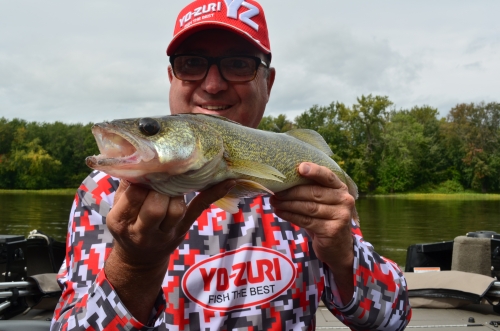
The rod and reel is really not too much of a concern to me, but I have found that line is very important; remember you are dealing with tooth critters. For me if I am fishing open water I will run straight 14-20lb Yo-Zuri TopKnot Mainline 100% Fluorocarbon. The small the line the deeper depths the bait will go. However, if I am targeting areas that have a lot grass or I am running multiple rods behind the boat I will usually run 30lb Green SuperBraid with fluorocarbon leaders. The braid helps stay more abrasion resistant in the grass.
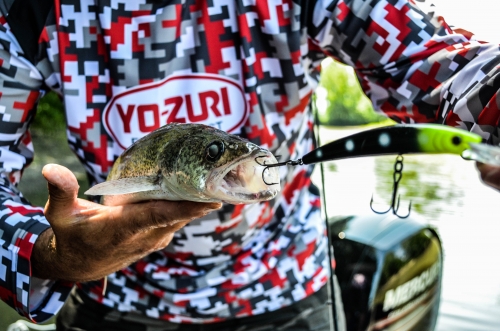
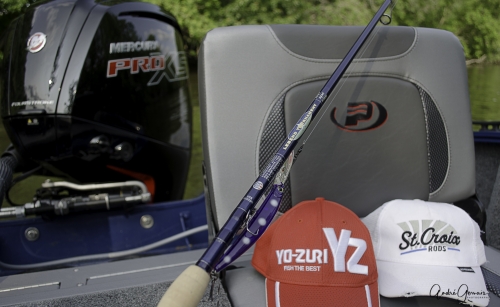
Finally the bait of choice, as I mentioned I throw the Yo-Zuri Crystal Minnow Walleye DD most of the time. This is a great bait because it dives really well, has a great action, and the colors are exactly what walleye target. Walleye prefer the really dark or the really bright colors. They are a weird fish when it comes to the color selection and resemble nothing of the natural forage. The colors I like the most are Zombie and Midnight, but will sometimes mix it up with Acid Perch and Hot Tiger. All of the colors offered by Yo-Zuri however are a great choice; these are just the ones I reach for most.
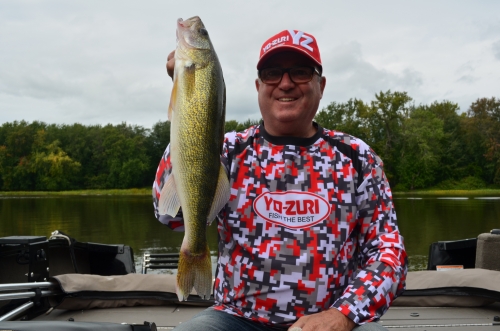
Enjoy the waters and don’t forget to bring home fresh walleye for dinner, as walleye are one of the best freshwater eating fish there is!
Take your Grandkids fishing with the Yo-Zuri Snap Bean – by Martha Goodfellow
Recently, I was blessed to have our two youngest grandkids come for a visit (ages five and three). They each had a week of their own, for what we teased was “Camp at the Grandparents.” One of our adventures was to go fishing at a friend’s pond. You should have seen the total delight and excitement on each of their faces as they caught one bream after another.
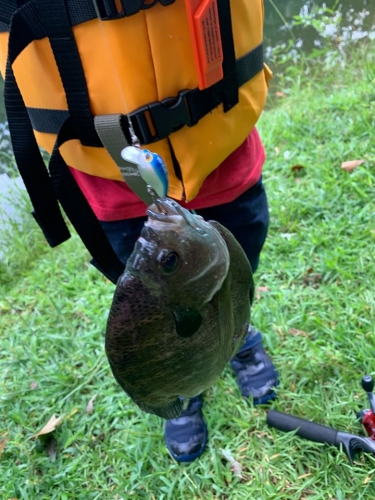
Each child had their own favorite pole and since they were the kid of the week, they could choose from several kid rods. Our grandson’s favorite was his kid spider-man pole. That pole was rigged with a Yo-Zuri Snap Bean in the silver/black back lure. Another had a silver/blue back Snap Bean. And, to mix it up a bit, we had one rigged with a plastic lure. Hands down, our five year old grandson loved using the Snap Bean. Instead of patiently waiting for a fish to find the plastic, he could slowly retrieve the Snap Bean and it kept his interest. Of course kids all have their own personalities and our 3 year old granddaughter loved using brother’s spider-man pole since he wasn’t there. J We rotated through using the Snap Bean and a plastic bait.
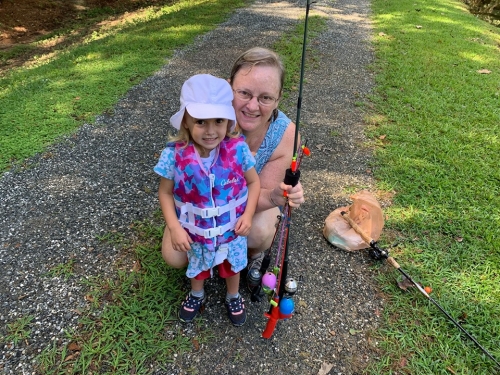
The Snap Bean worked great for the kids. Since it is a shallow diving crankbait, it stays close to the surface. The Snap Bean only weighs 1/16 oz and has one treble hook. To use on the kids poles and make it easier to get longer casts, I put a weighted bobber on the line above the lure. Using a bobber also helped the kids watch for when a fish was “playing” with their bait and for when they had a fish on.
Throw The Knuckle For A Great Change-Up- by Mark Maule
With August rapidly approaching, many larger northern pike have retreated to deep water weeds, deeper rock piles, or roam the basin in some cases chasing schools of baitfish. During this time, many anglers put away their northern pike gear because it can be more challenging to catch bigger fish than it is during the spring and fall seasons. However, if you can find the fish, they can be caught. One of my favorite lures to fish large northern pike during late July and throughout August is the Yo-Zuri 3DB Knuckle Bait.
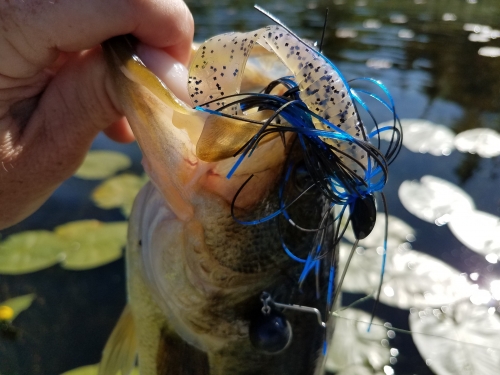
At 1/4, 1/2, and 5/8 oz. the Yo-Zuri 3DB Knuckle Bait can effectively be fished throughout the water column. The 1/4 oz. Knuckle is a perfect choice when fishing in water up to about 10’ above downed wood, right at the edge of weeds that drop into deeper water, or off of long points. The 1/2 oz. and 5/8 oz. Knuckle Baits are a great choice when fishing in water from 10-20’ deep while working the edge of weedlines and sharp drops or humps. The 5/8 oz. Knuckle Bait can also be a great option when pursuing large fish in the 15-25’ range over basins when they are chasing schools of baitfish.

Two of my favorite colors regardless of how deep I am fishing are the Golden Shiner and Tennessee Shad. The Golden Shiner 3DB Knuckle Bait is perfect for tannic or dirty water and the Tennessee Shad is an excellent choice for clear water conditions where the sun is high in the sky. With each pattern, it is recommended to use some kind of trailer. Normally, I go with a 4” or 5” plastic grub that emulates baitfish that are in the system. So, for example, when fishing the Golden Shiner Knuckle Bait, I might choose a grub that has some chartreuse and orange flecks in it because it mimics a bluegill that northern pike will be feeding on in weeds. When using the Tennessee Shad Knuckle Bait, I might go with a pearl or white grub to try for basin fish because these colors look like tullibees that northern pike might be chasing.
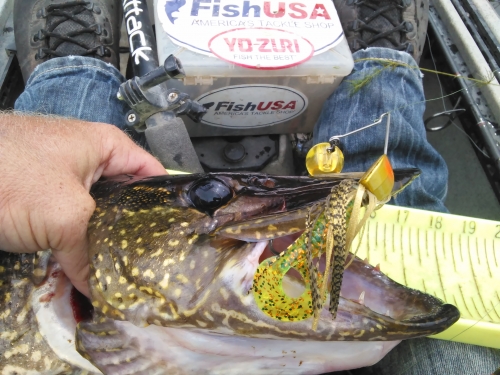
Fishing for large northern pike during summer can be daunting at times, but they can still be caught with relative frequency. Throwing the Knuckle as a change-up to patterns used in spring and fall can be a terrific way to keep you on the numbers and good-sized fish.
Chasin the Wester Stripers- by Joseph Tutelian

Rod: Cousins casting rod (SSW 79M-T) 7’9, 12-20 lb, extra fast tip; and Lamiglas Mark Wilson Striper Trolling rod (XCC 795) 7’9, 12-25 lb.
Reel: Diawa reel with a line counter when fishing with multiple people this helps coordinate each others distances behind the boat.
Fishing Line and Hardware: Yo-Zuri TopKnot Mainline fluorocarbon in 20lb test with a Owner 79 lb Hyper Crosslock Snap (a snap-swivel will rob the lure of its action)
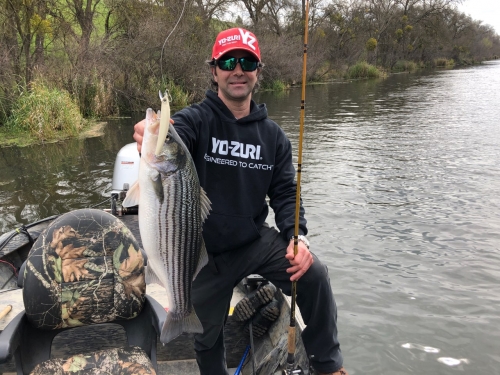
Lures: Yo-Zuri Crystal Minnow 5 1/4″ in bone white, pink, chartreuse, blue, and others. This lure has a very tight fast wiggle and dives a few feet deeper than the Yo-Zuri Hydro Minnow LC. The Hydro LC is just as effective as the Crystal Minnow, however I use the Hydro LC when trolling in shallower water because it dives from 3-6 feet deep depending on how far behind the boat you are trolling it (130 ft versus 200 ft.) The Hydro LC also has a larger profile than the Crystal Minnow; I like to downsize the lure when the bite is tough. In the Crystal Minnow I prefer the colors: Bone, Florescent Pink, and Chartreuse. The Hydro Minnow LC I always have the best luck on Bone or Purple Black.
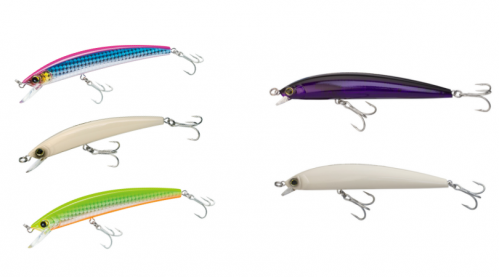
Fishing Technique/Application: Water in the river ranges from 48 degrees (winter/early spring) to 62 degrees (summer/fall, or further downriver). When I am fishing all of the above listed lures, I am trolling them upriver or downriver at speeds ranging from 2.5-3.5 mph, with my lure approximately 120-200 ft behind the boat depending on the depth of the hole I am trolling. Depending on what depth in the water column I am trying to fish, I will let out less line (i.e. 120 feet) to achieve a shallower depth, and more line (i.e. 200 feet) to achieve a deeper depth. Remember, you can also fish shallower or deeper in the water column by changing from the Crystal Minnow to the Hydro Minnow to the LC Minnow.
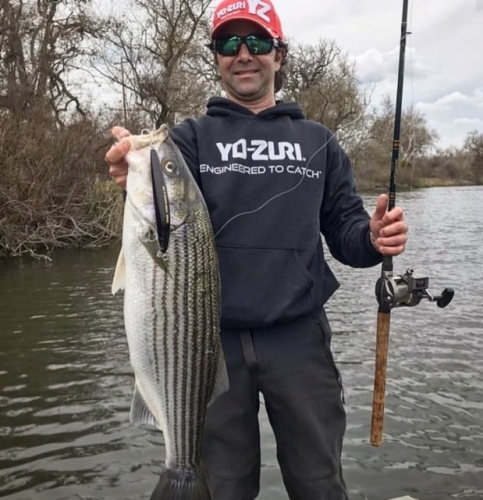
Another cool tip to note; to trigger reaction bites is to make the lures swim up or down in the water column by increasing or decreasing your troll speed. When using any floating lure, you can get it to swim down (or dive) by increasing your speed, and also get it to swim up by slowing down your troll speed. Sometimes doing this or trolling in a Z-pattern can trigger bites!!!
Yo-Zuri Prostaff angler Brandon Cobb Captures his first W
 Fishing as a professional bass fisherman comes with a lot at stake. It can be financially trying, emotionally exhausting, physically demanding, but can all pay off when the plan comes together. Every angler out there has one goal in mind; to WIN! But what if you are in front of your hometown crowd? The people that saw you grow-up, the friends you’ve known your whole life, your wife, your parents and grandparents, all your family, what if you were the angler everyone had their eye on through-out the week? Does the stakes of winning get higher? Is there more added stress? Do you expect more from yourself? Well that was exactly the cards dealt to Yo-Zuri Prostaff angler Brandon Cobb last week on Lake Hartwell for the Bassmaster Elites Series event in South Carolina.
Fishing as a professional bass fisherman comes with a lot at stake. It can be financially trying, emotionally exhausting, physically demanding, but can all pay off when the plan comes together. Every angler out there has one goal in mind; to WIN! But what if you are in front of your hometown crowd? The people that saw you grow-up, the friends you’ve known your whole life, your wife, your parents and grandparents, all your family, what if you were the angler everyone had their eye on through-out the week? Does the stakes of winning get higher? Is there more added stress? Do you expect more from yourself? Well that was exactly the cards dealt to Yo-Zuri Prostaff angler Brandon Cobb last week on Lake Hartwell for the Bassmaster Elites Series event in South Carolina.
How did Brandon do? He never even flinched and got the job done; winning his first Bassmaster Elite Series event in his career and taking home a $100,000 payday.
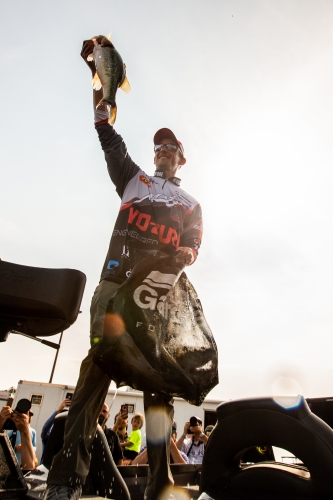
Brandon grew up in South Carolina and has fished Lake Hartwell his whole life, so knowing the lake was no problem. Making sure he didn’t let history interfere with his ability to fish clean and strong to capture the win; that was the difficult task. The Yo-Zuri pro knew he needed to stick to one area of the lake that was notorious for big bedding fish. He stuck to his plan and stayed calm.
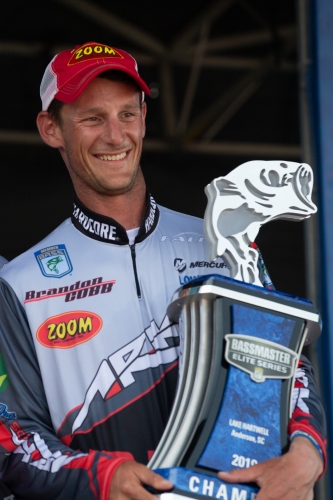
Brandon is a well-known angler that prefers to burn the bank and cover as much water as he could throwing moving baits. But, when the springtime hits and water is clear; the best way to catch them is with a spinning rod. Brandon threw a wacky worm throughout the tournament but still managed to cover as much fishable water as he could, even at times revisiting areas through-out the tournament days as fish continued to move up in his primary areas.
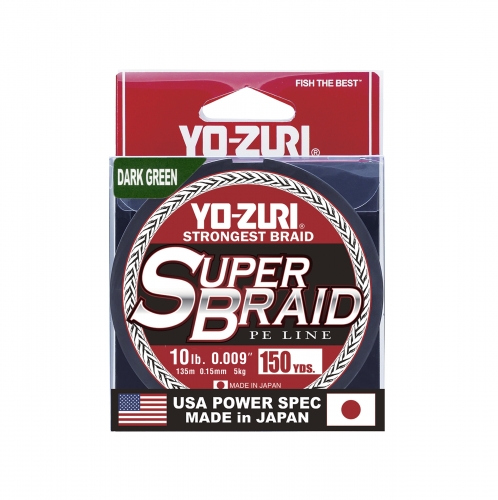
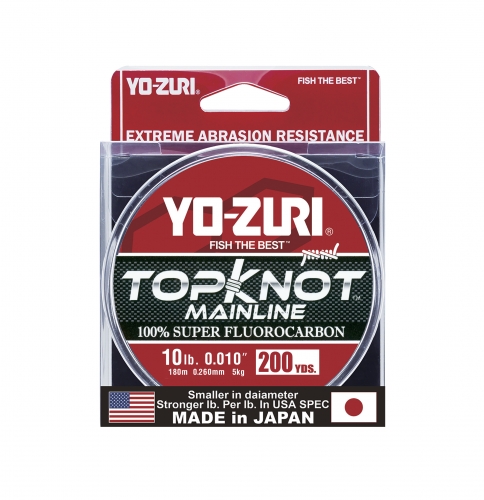
Brandon’s arsenal of attack was a 6’10 medium action spinning rod, 2500 size spinning reel, Yo-Zuri 10lb SuperBraid with a 10lb Yo-Zuri Topknot Fluorocarbon leader. Brandon was using this set up to throw a wacky worm to make long casts and catch cruising largemouth in bedding areas. Occasionally he would slow down and throw a shaky head for fish that were locked onto a bed, but most of the fish he weighed in were cruising shallow.
Braxton Setzer is Runner-Up at Seminole!!!

The FLW Tour held their third stop of the 2019 season this past weekend on Lake Seminole in Georgia. Among the angler’s that made a strong fight for the win was Yo-Zuri Prostaff angler Braxton Setzer. In what was one of the most electrifying final day performances, followed by a very emotional final day weigh-in, when the smoke cleared Braxton achieved his best finish on the FLW Tour.
“Second Place is not that bad at all, although it does sting, it was not my time and now I really feel like my time is coming,” says the 31 year old angler competing in his fourth year on the FLW Tour. “Practice was terrible on me as with the rest of the field, everyone was talking about how tough the fishing was during the meeting. If you told me I would have finished second I probably would have laughed at you”.
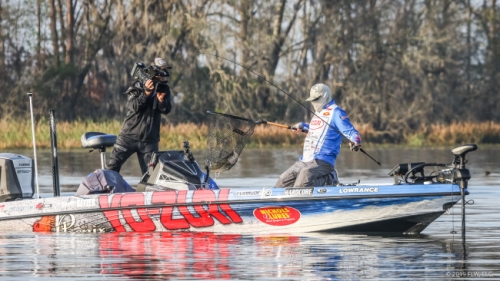
Braxton had very little confidence after practice and it took slowing down with a worm and swimbait to get those key bites during the tournament. In the grass were little highways and that is eventually what Braxton knew he found with locating a clean spot where he was catching his fish. The fish seemed to be suspended in 10 feet of water where the water was 12 feet deep.
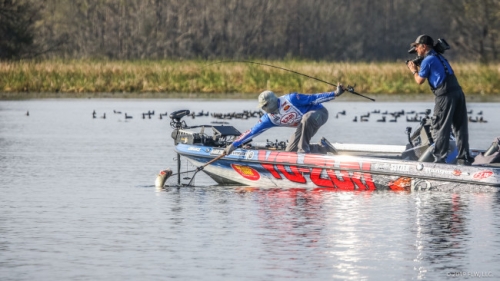
“During practice I was looking for flat areas that had a healthy amount of grass in it leading into spawning areas. The lake had just experience a cold front during the early part of the week and I felt like as the week went on it would get better,” reported Braxton. “The area where I caught 25lbs the first day and 23lbs the second I actually found casting around a Yo-Zuri 3/8oz Vibe. I got a bit with a keeper fish and then scanned around using my electronics and was able to locate a clean spot within the grass and I knew the transition would be useful throughout the tournament. It is also the only place I had confidence in.”
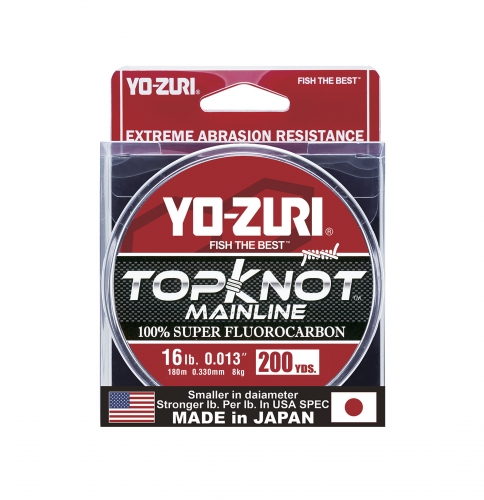
That magical spot really did pay off for Braxton, but it took all the way until the final day of the tournament to key in the exact presentation and cast.
“It really was a fun tournament and I am still in shock that I was able to crack the top-5. Definitely another key to my success was Yo-Zuri TopKnot fluorocarbon. I hardly had to retie all week never broke a fish off. One thing I will add about using the fluorocarbon that most anglers don’t do; I never change my line out every day of fishing. I’ve never had an issue with using the line multiple tournament days and multiple events. The line really holds up and is the quality anglers are demanding, for me it is dependent on my career.”
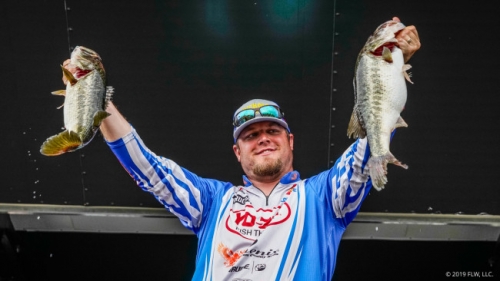
FLW Tour Lake Toho Top-20 Finish Recap- by Mike Surman
 The older I get in this sport the more a good finish means to me. With the changing technology, industry curves, and constant new talent making their way into the tour level; the harder it is for me compete against fellow anglers. However this past weekend in my current home state of Florida at Lake Toho, Mickey Mouse must have given me a little magic being so close to Disney World because everything came together.
The older I get in this sport the more a good finish means to me. With the changing technology, industry curves, and constant new talent making their way into the tour level; the harder it is for me compete against fellow anglers. However this past weekend in my current home state of Florida at Lake Toho, Mickey Mouse must have given me a little magic being so close to Disney World because everything came together.
The fishing in Florida has been really off so far this year. Between the low water in all the lakes, the Red Tide issues the entire state faced last year, and it still being early in the year the best fishing is still yet to come. This last week I was really able to pinpoint a good amount of fish that were pre-spawning and spawning. I used my local knowledge of the lake to lock into Lake Kissimmee and fish staging areas leading into spawning areas with good, healthy grass around it. With water temperatures in the mid-60s I knew as the week processed the fish would continue to move up.
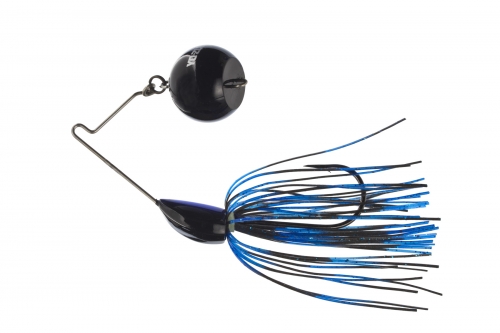
In practice I was really able to capitalize on a morning pattern and then an afternoon pattern, a key to my success knowing I could stay calm throughout the day and capitalize on the different patterns when they were at their best. In the mornings I was catching fishing on a 1/4oz Black and Blue 3DB Knucklebait with a soft plastic swimbait trailer. I was able to catch a couple really good fish on this and thought it would be a key bait for me throughout the tournament. I was throwing the Knucklebait over submerged grass around staging areas. As the afternoon took place and the sun got high I was able to pitch to hydrilla mats and dollar pads with a soft plastic stickworm catching spawning fish.
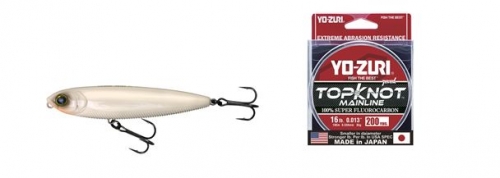
In the tournament, the morning Knucklebait bite had died but I was still able to capitalize catching these same fish using a 3DB Pencil in Bone color. For this technique I was throwing 20lb Yo-Zuri Hybrid line, and I was making short casts with it. I think the bait has better action when making shorter casts and not having so much stretch in the line. In the afternoons I was able to again capitalize again on the plastic stickworm bite. I was fishing the worm on a little [1/16oz] weight and throwing it on 16lb Yo-Zuri TopKnot Mainline Fluorocarbon.
One of the last factors that helped me was covering water in an area. I was fishing a massive area of Lake Kissimmee and it seemed like covering water and then breaking down an area once I got a bite was the key to capitalizing on water holding fish.
